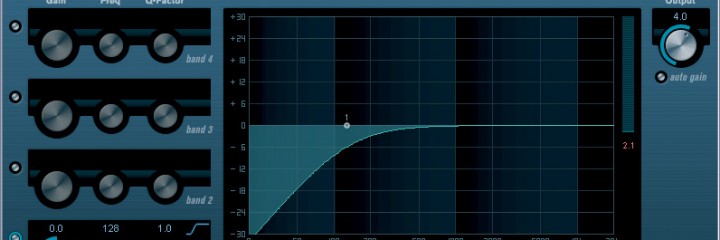EQ is probably the real emblem of mixing, the base of every mix that you can call “professional”. Using EQ correctly you could find you don’t need anything else to mix, just EQ and compression.
In audio engineering world, you always hear “High Pass Filter” and “Low Pass Filter”, but what are they? They’re just EQ with one frequency only. Above or below that frequency everything is cut and the remaining frequencies “pass” through. With an High Pass Filter you make all the spectrum above the frequency you set to pass, cutting everything below. With a Low Pass Filter you do exactly the opposite. Simple, insn’t it?
I like to use filters, I use them as a starting point for everything I think a track needs to sit well in a mix, I mean, on every track. You can take it as a rule of thumb, each track has a lot of frequency information on the lower part of the spectrum that is not needed. If you don’t filter, you could have serious problems when you have lot of tracks. A distorted guitar (even with the most distorted sound in the world) doesn’t need quite anything below 100Hz, you can test it. When the number of tracks in a mix becomes higher you could start to have serious muddiness or boominess problems if you don’t filter, especially with guitars in heavy metal mixes. An High Pass Filter is what can save your mixes as the tracks increase, if you use it the right way you can A) keep your mix “clean” and B) delete from each track what is not needed. We can say that these are all “technical” advices.
In a mix you can use filter even in a more “creative” and crafting point of view: if you read my post on layered bass, you could remember how I used EQ to build the sound, they were exactly an High Pass Filter and a Low Pass one. But you can use it also on backing vocals tracks! A low Pass is a blessing when it comes to “push back” choirs and backing vocals, to let the lead stand out. This way you can blend lead vocals and backings way better. Just try, a simple filter can save your mix life.
To show you the benefits of filters, I recorded quickly this clip: double tracked guitar (pan hard left, hard right), bass and a drums part composed with the standard kit of EZDrummer. I didn’t EQ anything, I just filtered. If you listen to the file before and after applying the filters with good studio monitors or good headphones you’re going to hear a big difference: on guitars the LPF will cut the “digital” sound of the amp simulator (TSE X50 with God’s Cab, check out my post on heavy guitar tone for dummies with free plugins) that can be annoying on high frequencies, the HPF cleans kick and bass to better blend them.
This is the clip without filters:
And this is with filters:
To make it more clear, here you are just the guitars, before and after the filters:
Before:
After:


Leave me a Comment